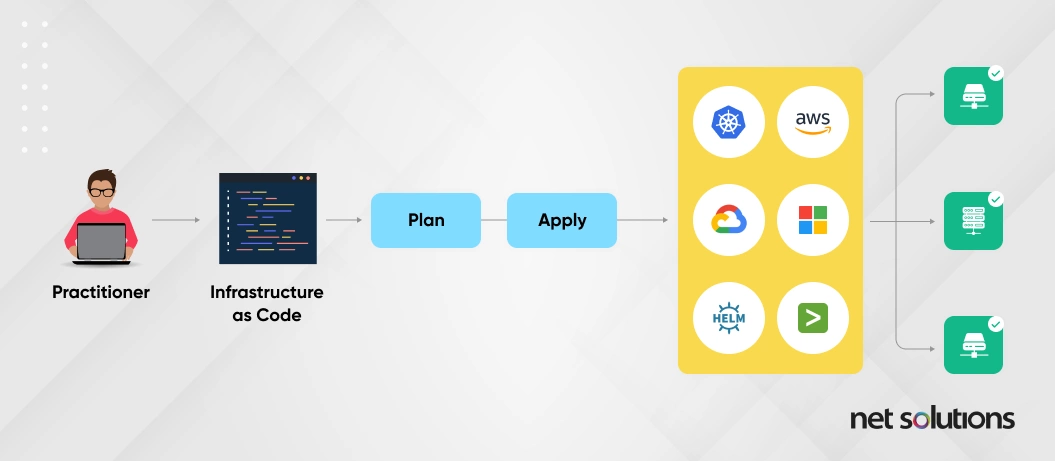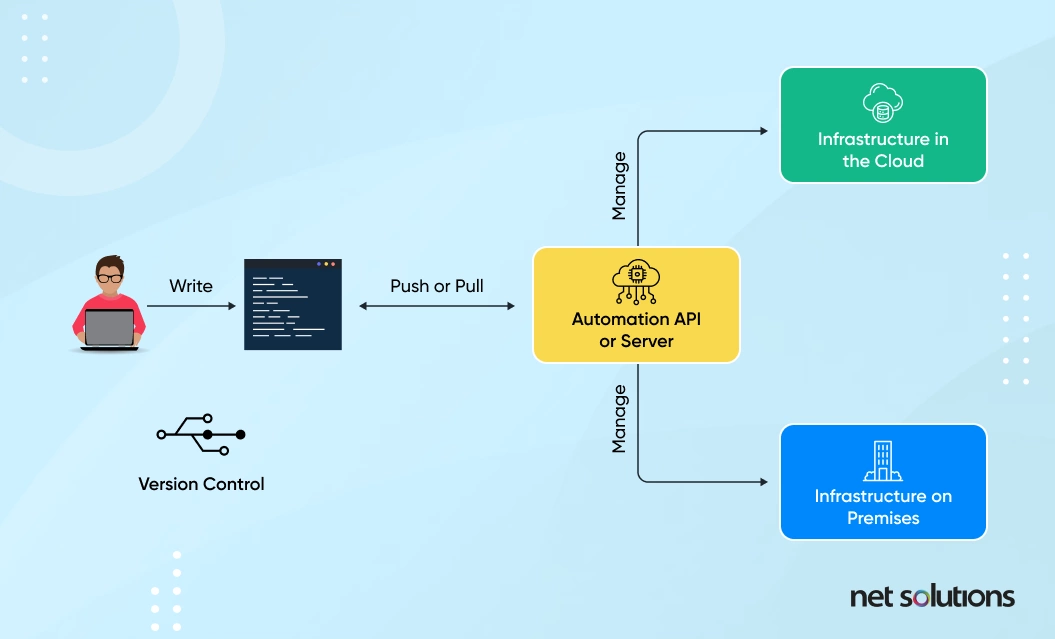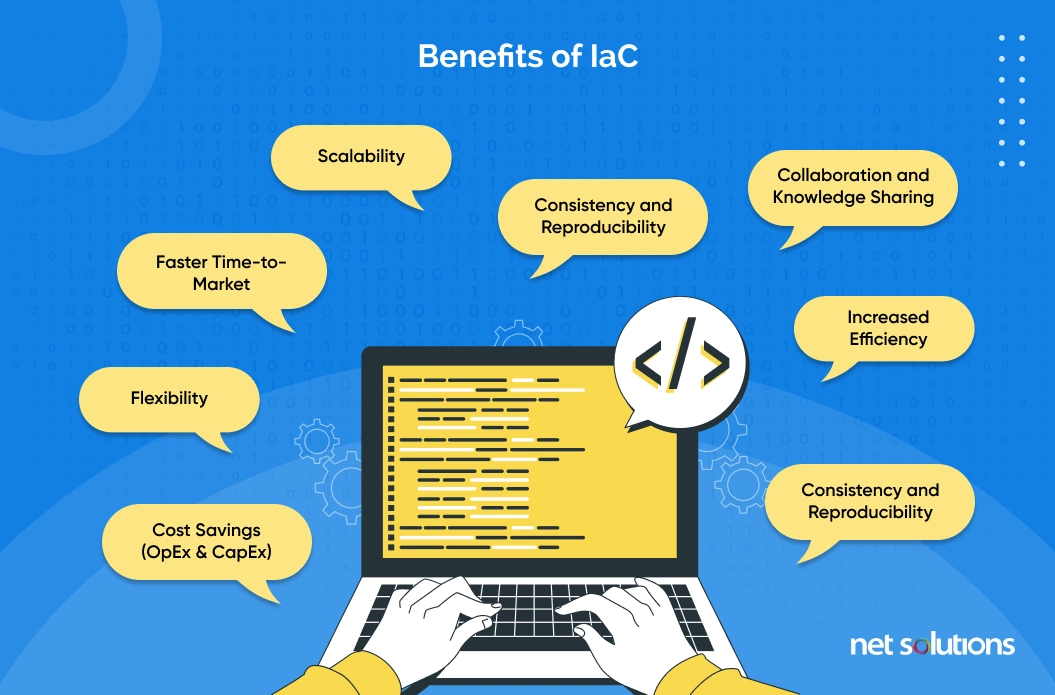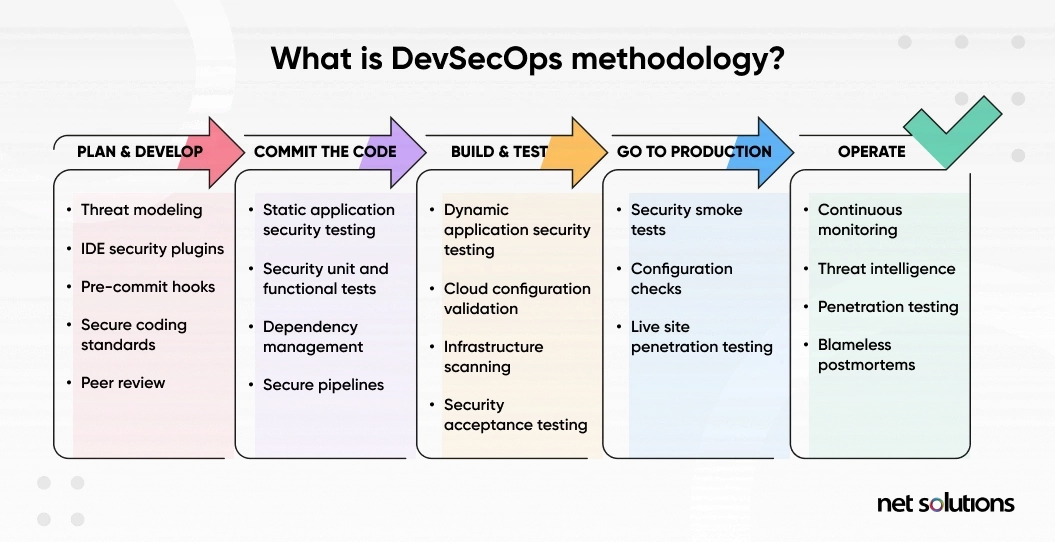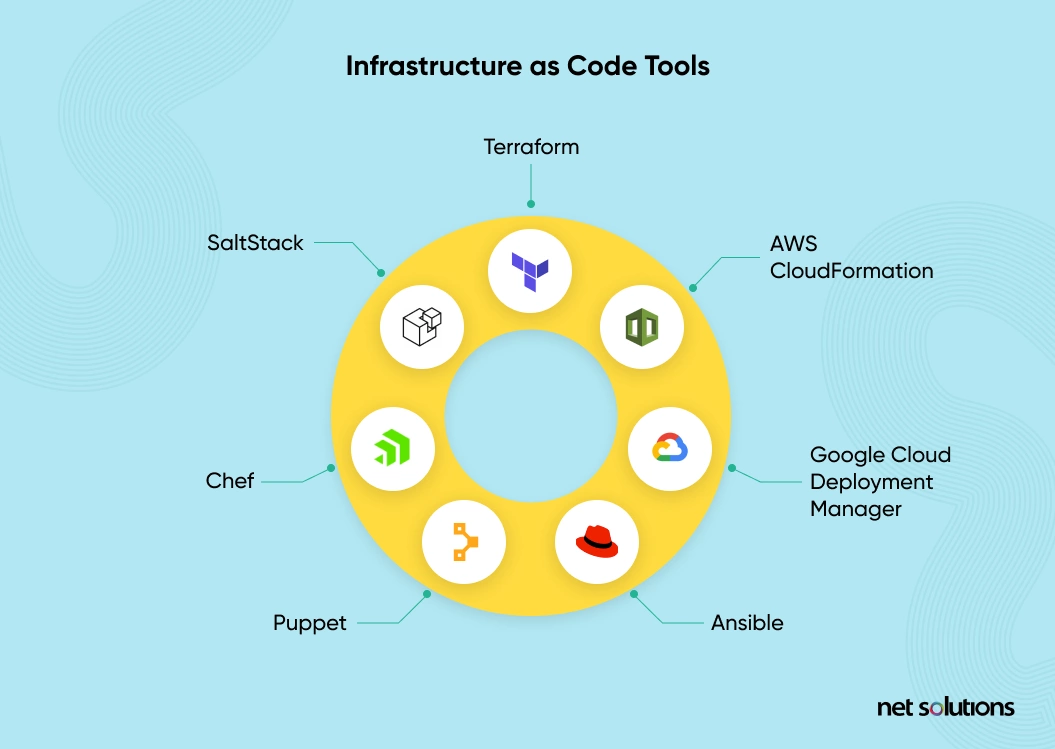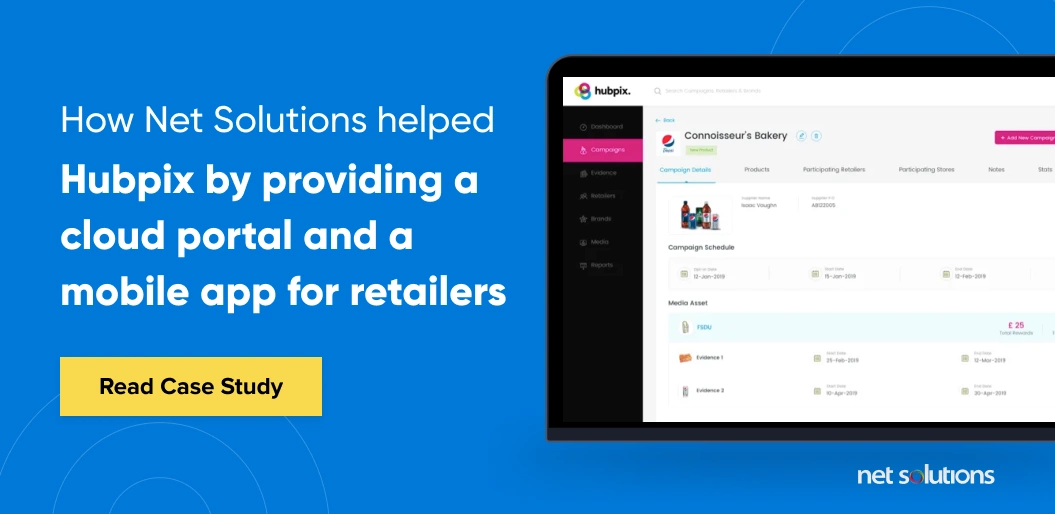Learn how infrastructure as code is being used across enterprises to reduce manual effort, optimize resource allocation, speed deployment and improve the agility and scalability in cloud environments.
Infrastructure as Code (IaC) enables the automation of managing and provisioning infrastructure through code instead of manual processes. Fueled in part by the growth of cloud computing, application modernization and Agile software development cycles, organizations increasingly turn to IaC to add efficiencies to infrastructure management.
According to the most recent State of the Octoverse from GitHub, IaC practices are being increasingly adopted, with notable heavy growth in Hashicorp Configuration Language (HCL), Shell, and Go (Golang) languages – languages that power IaC. The IaC market is expected to grow with a CAGR of 24% to 26% between 2023 and 2028.
This guide will detail infrastructure as code, the relationship between infrastructure as code in DevOps, the infrastructure as code benefits and IaC best practices, and what IaC tools to use to get started.
What is Infrastructure as Code?
What is meant by infrastructure as code? Infrastructure as code is an approach to managing and provisioning infrastructure resources (e.g., data centers on-premise or in the cloud) using machine-readable configuration files/scripts (what we refer to as “code”). The IaC approach treats the hardware as software, allowing for a more consistent and version-controlled approach to managing infrastructure at scale.
What issues does infrastructure as code solve for a business?
Traditionally, infrastructure had to be managed by hand: the server had to be installed on a rack, OS installed, and the network connected and configured. Any change (e.g., new servers) or issue could take hours or days. That kind of downtime and inflexibility is not adaptable in a constantly changing business environment.
In modern software development, Development and Operations (DevOps) teams work to scale development and deployment processes to both cloud and on-premise infrastructure. DevOps practices such as IaC can result in faster delivery times, more secure systems and a supported continuous integration/continuous development (CI/CD) pipeline.
The business benefits include:
- Consistency of deployments to support CI/CD
- Efficiency through automation
- Scalability
- Greater version control
- Reduced vendor lock-in
How does infrastructure as code work?
Infrastructure as code uses tools and programming languages to provision and manage infrastructure (cloud and on-premise), including servers, storage, databases, and networking. Instead of working directly with the infrastructure, IaC declares what the desired outcome/system should look like, which is then read and executed by an automation tool.
Examples of Infrastructure as code
There are four main approaches to IaC leveraging programming and tools:
- Scripting: Developers write short scripts. Ideal for small tasks.
- Configuration management (CM) tools: Tools specialized in configuring servers and tracking changes over time.
- Provisioning/infrastructure orchestration tools: Tools specialized in creating infrastructure and making it available (e.g. installing a database on a server or configuring a network).
- Containers and templating tools: Tools that generate templates with all necessary libraries for running an application. It is common to use containerized workloads.
Infrastructure as Code: Benefits
To answer the question of “Why Infrastructure as Code,” one must examine the business benefits of infrastructure as code. Overall, IaC is a method of automation that is helping organizations meet the challenges of today’s marketplace, replacing time-consuming manual processes with a more scalable, efficient approach to infrastructure management.
Let’s take a complete look at the overall advantage of infrastructure as code:
1. Increased Efficiency
Once defined through code, many manual processes can be replaced with automation, helping accelerate deployment cycles, minimize human error, and improve security operations.
2. Consistency and Reproducibility
One of the top benefits is the ability to define configurations and apply the same configurations consistently across multiple environments – both fast and consistent for long-term manageability and reduce drift over time (when different environments start to get out of sync in configurations).
3. Version Control and Change Management
By leveraging version control systems, it’s possible to track and manage changes over time and roll back changes if needed.
4. Collaboration and Knowledge Sharing
Version control (e.g., Git) allows multiple people to view and work on the same codebase, supporting collaboration and knowledge sharing and encouraging best practices that can be leveraged across teams. The IaC code can become a “best practice” documentation for the infrastructure.
5. Scalability
Infrastructure resources can be provisioned or scaled automatically; no manual intervention is required.
6. Faster Time-to-Market
IaC replaces manual deployment processes, including testing and validation, and integrates with CI/CD pipelines to help streamline development and ensure it is deployed in a controlled and consistent manner.
7. Cost Savings (OpEx & CapEx)
Cost savings come from replacing time-consuming manual tasks with automation, better-defining infrastructure needs (automated scaling), supported CI/CD pipelines, improved backup and disaster recovery strategies, and ensuring consistent deployments to reduce issues and maintenance.
8. Flexibility
Abstracting infrastructure configuration makes it easier to deploy and migrate to different platforms (on-premise and cloud), flexibility that helps reduce vendor lock-in.
Take control of your infrastructure with our infrastructure as code services.

Infrastructure as Code Best Practices
While infrastructure as code has many benefits, challenges include a need for IT skills, security challenges, misconfiguration errors, and complexity leading to versioning challenges. To avoid the difficulties that can come with IaC, it is best to adopt the following IaC best practices:
1. Use version control systems to manage infrastructure code changes
A version control system (e.g. Git) stores infrastructure configurations as code, tracking changes and supporting rollback.
2. Conduct code reviews to ensure high-quality infrastructure code
Manually review code to identify bugs, maintain quality, and foster collaboration among team members.
3. Test infrastructure code to catch bugs and prevent errors
Various tests (unit, regression, integration) should be applied, ideally with automation, each time a change is made to the configuration code. Security testing should also be monitored (see DevSecOps).
4. Break infrastructure code into reusable modules for increased flexibility
Modular / microservices-based architecture can be applied to IaC, breaking infrastructure into pieces that can be managed independently, allowing for greater system resiliency.
5. Document infrastructure code and changes to facilitate understanding and maintenance
The infrastructure specifications in the configuration files serve as the single source of truth; no other documentation is needed (risk: additional documentation can get out of sync).
6. Incorporate security best practices into infrastructure code design and implementation.
Most organizations that look to IaC will follow DevSecOps best practices to build security right from the start of the project and ensure automated security testing. Integrate tools like Amazon’s IaC scripts (GuardDuty, Macie, Inspector) or third-party tools like Snyk.
7. Design infrastructure code with scalability in mind
Choose tools with scalability in mind, as some organizations deal with sprawl and difficulties managing security and compliance across modules and environments. Ideally, configure using a centralized module repository to simplify.
8. Implement monitoring and logging to detect and diagnose infrastructure issues
Leverage infrastructure and cloud logging and monitoring tools to identify gaps in security before an attack or system failure. Leverage in-built monitoring (e.g., AWS) as well as third-party detection tools (e.g., SIEM, incident management tools, dashboards)
Infrastructure as Code Tools
Tools for IaC fall into four functional buckets: tools to provision/create infrastructure, tools to manage infrastructure, means to set up applications, and tools to deploy configurations/changes after installation.
Some of the top infrastructure as code tools are:
1. Terraform
Terraform is one of the top tools for managing IaC, an open-source tool that can be used in any supported platform (vendor-neutral to Microsoft Azure, Google Cloud, AWS, Oracle, etc.).
2. AWS CloudFormation
AWS CloudFormation is an IaC tool provided by Amazon Web Services, using JSON or YAML, and extensible to other cloud resources published in the CloudFormation registry.
3. Google Cloud Deployment Manager
The Google Cloud Deployment Manager is an IaC service to automate the creation and management of Google Cloud resources.
4. Ansible
Ansible is an open-source suite of tools for software provisioning, configuration management, and application deployment, one of the top tools for managing IaC.
5. Puppet
Puppet uses its language for automating configuration management, compliance, CI/CD, patch management, and more.
6. Chef
Chef (Progress Chef) is a configuration management tool in Ruby and Erlang. Chef leverages the concept of “recipes” for system configurations, focusing on security and compliance.
7. SaltStack
SalStack is a Python-based, open-source software for IaC automation.
The IaC tools are developed with a specific purpose in mind. Depending on the particular need, one tool may be better than the other.
How Net Solutions Can Help
Net Solutions helps design, develop and modernize software applications leveraging the latest technologies and DevOps services. The company has been using Terraform, for example, for clients in the fields of health and online bidding. Talk to our digital transformation experts to learn more:
Frequently Asked Questions
-
01
What is the difference between IaaS and IaC?
Infrastructure as a Service (IaaS) refers to cloud computing for virtualized access to computing resources (e.g., storage and server space) to host software solutions, build data centers or conduct data mining. IaC is the approach to provisioning and managing those resources.
-
02
Is Kubernetes infrastructure as code?
Kubernetes is a container-orchestration system that can help automate the deployment and management of containerized applications. Kubernetes can use IaC practices to manage clusters and add-ons (e.g., IAM, network policy).
-
03
What are the 3 types of IT infrastructure?
There are three types of IT infrastructure:
- Traditional on-premise infrastructure: servers, computers physically owned and managed
- Cloud infrastructure: delivery of infrastructure services from the cloud
- Hyperconverged: the virtualization hardware-defined systems (traditional) to provide a unified way to manage infrastructure.
-
04
What is declarative infrastructure as code?
There are two methods of turning infrastructure configurations into code:
- Declarative (functional) – defines the desired outcome/state of the final solution, but the automation tool chooses the method to achieve that
- Imperative (procedural) – represents the steps/commands necessary to achieve the desired outcome


 Updated: June 19, 2023
Updated: June 19, 2023


